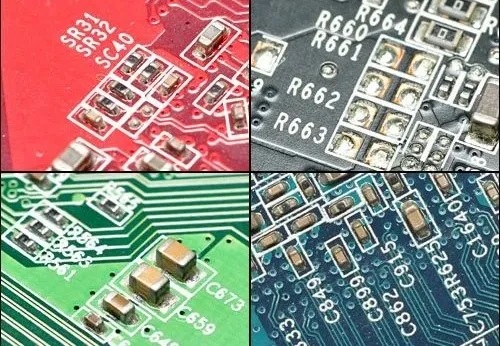The purpose of the process itself, both for gold-plated PCBs and silver-plated PCBs, is to prevent oxidation and to protect the pads so that the gold-plated PCBs and silver-plated PCBs can be soldered with good yields in the subsequent soldering process.
The use of different metals will require the production plant to use the PCB storage time and storage conditions. In this case, PCB factories generally use vacuum sealing machines to package PCBs before they are finished and delivered to customers to ensure that no oxidative damage to circuit board occurs to the limit.
The copper layer of PCB without soldermask coating is easy to oxidise when exposed to the air.
We know that the front and back of the PCB are copper layers. In the production process of PCB, no matter whether it is made by adding or subtracting, the copper layer will have a smooth and unprotected surface.
Although the chemical properties of copper are not as reactive as aluminium, iron and magnesium, pure copper is easily oxidised by contact with oxygen in the presence of water. Due to the presence of oxygen and water vapour in the air, the oxidation reaction of copper on the surface of pure copper in contact with air will occur very soon.
Due to the thin thickness of the copper layer in the PCB, the oxidised copper will become a bad conductor of electricity, which will greatly damage the electrical performance of the whole PCB.
To prevent copper oxidation, separate the soldered and unsoldered portions of the PCB during the soldering process, and protect the PCB surface, engineers have developed a special coating. This coating can be easily applied to the PCB surface to form a protective layer of a certain thickness, blocking the copper from contact with air. This coating is called soldermask and the information used is soldermask paint.
Since it is called paint, it must have different colours. Yes, the original soldermask can be colourless and transparent, but for ease of maintenance and manufacturing, PCBs often require tiny text to be printed on the board.
Transparent soldermask can only show the base colour of the PCB, so it does not look good for either manufacturing, maintenance or sales. So engineers add various colours to the soldermask to produce black or red or blue PCBs.

Gold-plated PCBs and Silver-plated PCBs
Black PCBs make it difficult to see the wiring, which makes maintenance difficult.
From this point of view, the colour of the PCB has nothing to do with the quality of the PCB. The difference between a black PCB and a blue PCB, or a yellow PCB and a PCB of another colour, is the colour of the soldermask applied.
If the design and manufacture of the PCB are identical, the colour will not affect the performance or the heat dissipation.
As for the black PCB, it is an inconvenient colour to manufacture and use because the surface wiring is almost completely covered and maintenance is very difficult.
Therefore, in recent years, people gradually reform, give up the use of black solder resist paint, and use dark green, dark brown, dark blue and other solder resist paint, the purpose is to facilitate the manufacture and maintenance.
At this point, the PCB colour problem is basically clear. The reason for the emergence of ‘colour or low’ said, is because manufacturers like to use black PCB for high-end products, and red, blue, green, yellow, other low-end products.
What are the benefits of using precious metals such as gold and silver on PCBs?
Colour to see clearly, and then talk about the precious metals on the PCB! Some manufacturers in the publicity of their products, will mention their products are gold-plated, silver-plated and other special processes, so what is the use of this process?
PCB surface needs to be soldered, need to expose part of the copper layer for soldering. These exposed copper layers are called solder pads, which are usually rectangular or circular in shape with a small area.
We know that the copper used in PCBs oxidises easily, so after applying soldermask, it is the copper on the pads that is exposed to the air.
If the copper on the pads is oxidised, not only will it be difficult to solder, but the resistivity will also increase, seriously affecting the performance of the final product. So engineers have come up with various ways to protect the pads. For example, electroplating inert metal, covering the surface with silver chemistry, or covering copper with a special chemical film to prevent contact with air.
Bare solder pads on the PCB are directly exposed to the copper layer. This part needs to be protected from oxidation.
And before soldering the components on the machine, the board manufacturer also needs to check the level of oxidation on the PCB to eliminate oxidised PCBs and ensure yield. Oxidation occurs almost exclusively at the plug-in connections and has no effect on the pads and components that have already been soldered.
Since silver and gold have lower resistance, will the use of special metals such as silver and gold reduce the amount of heat generated during PCB use?
As we know, the factor that affects the heat value is resistance. Resistance is related to the material of the conductor itself, the cross-sectional area of the conductor and its length. The thickness of the metal on the surface of the pads is even much less than 0.01mm, and if the pads are treated with OST (organic protective film), there will not be any extra thickness. The resistance exhibited by such a small thickness is almost zero, or even impossible to calculate, and certainly does not affect heat dissipation. The purpose of the gold-plated PCB and silver-plated PCB process itself is to prevent oxidation and protect the pads.